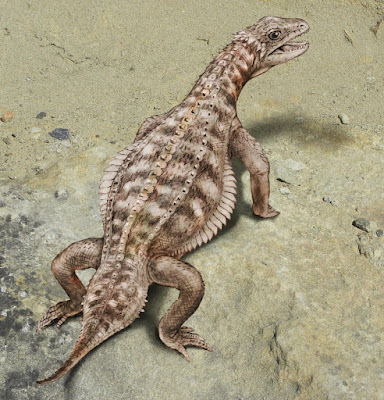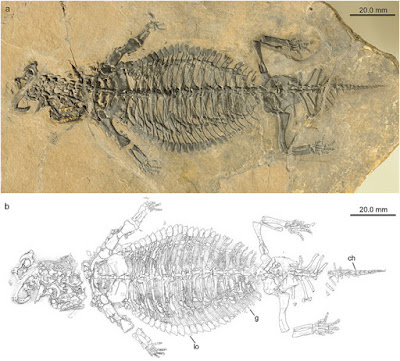 |
| Eusaurosphargis dalsassoi Nosotti & Rieppel, 2003 |
Abstract
Recently it was suggested that the phylogenetic clustering of Mesozoic marine reptile lineages, such as thalattosaurs, the very successful fish-shaped ichthyosaurs and sauropterygians (including plesiosaurs), among others, in a so-called ‘superclade’ is an artefact linked to convergent evolution of morphological characters associated with a shared marine lifestyle. Accordingly, partial ‘un-scoring’ of the problematic phylogenetic characters was proposed. Here we report a new, exceptionally preserved and mostly articulated juvenile skeleton of the diapsid reptile, Eusaurosphargis dalsassoi, a species previously recovered within the marine reptile ‘superclade’, for which we now provide a revised diagnosis. Using micro-computed tomography, we show that besides having a deep skull with a short and broad rostrum, the most outstanding feature of the new specimen is extensive, complex body armour, mostly preserved in situ, along its vertebrae, ribs, and forelimbs, as well as a row of flat, keeled ventrolateral osteoderms associated with the gastralia. As a whole, the anatomical features support an essentially terrestrial lifestyle of the animal. A review of the proposed partial character ‘un-scoring’ using three published data matrices indicate that this approach is flawed and should be avoided, and that within the marine reptile ‘superclade’ E. dalsassoi potentially is the sister taxon of Sauropterygia.
 |
| A life reconstruction of Eusaurosphargis dalsassoi based on new specimen PIMUZ A/III 4380.
Illustration: Beat Scheffold.
|
Systematic Palaeontology
Diapsida Osborn, 190321.
Eusaurosphargis dalsassoi Nosotti and Rieppel, 2003.
Holotype: BES SC 390 (Palaeontological Collection of the Museo Civico di Storia Naturale di Milano, Italy), an associated but disarticulated specimen from the Besano Formation (242 Ma, Anisian-Ladinian, Middle Triassic) of Besano, Lombardy, Italy.
Referred specimen: PIMUZ A/III 4380, an almost completely articulated skeleton preserved in ventral view (Fig. 2a).
Stratigraphy and locality: Upper Prosanto Formation (bed no. 1; fossil found on bottom side of a limestone slab); 241 Ma, early Ladinian, Middle Triassic of Ducanfurgga locality no. 4, south of Davos, Canton Grisons (Graubünden), south-eastern Switzerland.


Torsten M. Scheyer, James M. Neenan, Timea Bodogan, Heinz Furrer, Christian Obrist and Mathieu Plamondon. 2017. A New, Exceptionally Preserved Juvenile Specimen of Eusaurosphargis dalsassoi (Diapsida) and Implications for Mesozoic Marine Diapsid Phylogeny.
Scientific Reports. 7, 4406. DOI: 10.1038/s41598-017-04514-x
Scientific Reports. 7, 4406. DOI: 10.1038/s41598-017-04514-x
Rare, exceptionally preserved fossil reveals lifestyle of ancient armor-plated reptile phy.so/418006972 @physorg_com
Davoser Saurier zeigt erstmals seine bizarre Schuppenpanzerung
http://www.idw-online.de/-ClXPAA
http://www.idw-online.de/-ClXPAA
